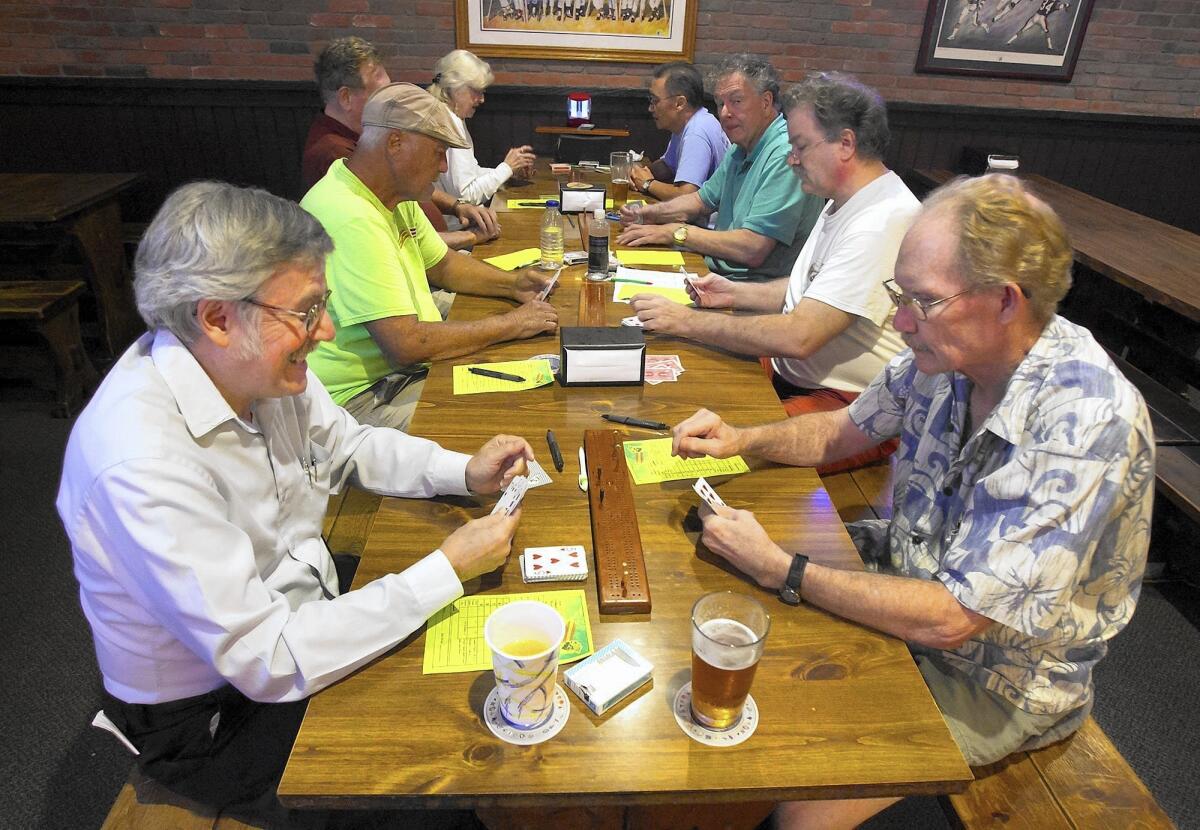Pegs, points and pizza: Cribbage lovers from O.C. and beyond gather once a week to play

- Share via
Fifteen-2, 15-4, 15-6 and 6 is a dozen.
Barry Mednick of Yorba Linda is adding up the value of his cards.
He has been squaring off against Jim “J.J.” Stansfield of Costa Mesa during an intense game of cribbage at Lamppost Pizza on Warner Avenue in Huntington Beach. As intense, that is, as a card game that dates to the 1600s and involves moving little pegs around a board can get.
Actually, the players will tell you that the game is fun, mentally stimulating and, yes, intense at times.
At the weekly gathering of the Surf City 29ers, formerly called the Alondra 29’ers, the laughs, chatter and gentle ribbing belie the underlying competition.
These players are no wimps. Carol Crowell, 77, lives in Rancho Palos Verdes and is in a wheelchair, and she takes a cab to the Tuesday night games in Huntington Beach.
Bill Eilers, 71, of Tustin had a stent put in the day before and refused to be waylaid by the procedure. He was there, ready to go.
Many have traveled long distances for tournament competitions.
“I’ve flown as far as Winchester, New Hampshire, to play cribbage in Maine. To Wisconsin once,” said Stansfield, of Costa Mesa. “There are truly dedicated — read obsessed — players that fly all over the country many weeks a year to play.”
So loyal a player is Pat Hendsch of Huntington Beach, who has been at it for 49 years, that her 70th birthday two years ago was celebrated with a cribbage party.
“My future mother-in-law said you will learn the game, and you will teach my grandkids,” recalled Hendsch, who followed through on the, uh, request.
On this recent night, 14 players were seated at two long tables, one person across from another. The seating arrangement was by-the-book random placement.
The two people facing each other were playing their own game. After all finished that round, the players got up and moved to the right, changing partners. It would go on like that through nine games, all meticulously recorded for entry with the American Cribbage Congress Grass Roots, a nonprofit organization with nearly 200 local clubs in North America.
Here, as simply put as possible, is how the game is played, based on a two-person match:
Each player is dealt six cards, and each player must discard two, which go face-down into the “crib.” The crib belongs to the dealer (the dealer is determined by a cut of the cards).
The crib plays a big role in cribbage strategy. The dealer has the advantage of saving good cards in his crib. The non-dealer will aim to give the dealer as weak a hand as possible while not jeopardizing his own.
A starter card is pulled from the deck and laid down, face up.
Players then take turns laying down their cards — in their individual piles, not blending the hands — calling out the face value of the total, which cannot exceed 31.
For instance, Player 1 might put down a 5 of hearts. The opponent responds by putting down a 10 of clubs, equaling 15, the magic number. Two points go to Player 2. If Player 1 has a 10 of any suit, he can play that for a pair — matching the numeric value of the last card, the 10 of clubs — also worth two points.
At this point, the cards played in this example add up to 25. To not surpass 31, Player 2 would have to have a card worth 6 points or less. If he doesn’t, he calls “go,” and a point goes to his opponent. This goes on until all the cards of been laid down.
The players’ pegs are moved around an oblong wooden board to reflect the points scored.
Now, the players tally their cards. The turned-up card factors in all hands.
The players will be looking for combinations that add up to 15 — counted in increments of 2 points, as in 15-2, 15-4, 15-6, 15-8 and so on — plus runs, three of a kind, four of a kind, flushes and more. Again, the pegs are moved around the board to reflect the points obtained.
Then the cards are shuffled, new hands are dealt and the process continues until someone reaches the end of the board.
People tout the family-friendly nature of the game and the math education it gives youngsters. Many players were taught by family members when they were young.
Leeann Kaai, 47, has been playing since she was 5. Her dad taught her — to help her learn how to count.
“I grew to love the game,” she said.
Artland Kaai, 72, was 7 when his dad taught him.
“In first grade I was the fastest one in math because of cribbage,” he said.
The father and daughter, both from Costa Mesa, both play in the Tuesday night Surf City club.
Hendsch, who taught her grandchildren the game, said it teaches kids math and comprehension because of the need to sort out all the number combinations.
“They see things in a different light,” she said.
Eileen Brown of Costa Mesa believes the game is “good for your brain,” no matter what your age. She is 86.
Cribbage has been around since the 1600s, when Sir John Suckling of England, a poet and a gambler who was reportedly a shady character, was said to have invented it.
Suckling apparently distributed large numbers of packs of marked cards to the aristocratic set and then went around the country playing them, winning quite a bit of money, according to Cribbagecorner.com.
Money is part of the Tuesday night play, but no one is going to get rich. Eilers, meanwhile, tells of a potential pot of $1,400 at a tournament. Tournament play takes place across the country and is a second type of cribbage competition unconnected to the local Grass Roots games.
Players also compete for points. Stansfield said he has just short of 2,000 Grass Roots points.
“When I hit 2,500, I’ll earn what they call the silver award,” he said, adding that this is his accumulation since 2005.
“Several of us try our best to be the club champion at the end of the 36-week season,” said Stansfield, who earned that distinction in 2014 with a seasonal score of 269. “Ours is a very tough club, in that we’ve only had a couple of repeat winners in the last 12 years.”
Regarding tournament competition, he has just shy of 1,700 American Cribbage Congress “master rating points,” and when he reaches 2,000, he’ll be a “master.” The best players have in excess of 30,000 MRP, he said, “but they’ve been playing forever and most every week forever.”
“It’s an easy game to learn to play, but tough to learn to play well,” Stansfield said. “It takes most folks years to feel like they’re a good player relative to the truly good ones. Lots of luck is involved, so in any given game, a knucklehead can beat an expert, but in general, the better players rise to the top of the rankings consistently.”
***
More Info
For more information about the game, visit cribbage.org. To learn more about Surf City 29ers, contact Jim Stansfield at jjstansfield@gmail.com or call (714) 337-7819.
More to Read
Go beyond the scoreboard
Get the latest on L.A.'s teams in the daily Sports Report newsletter.
You may occasionally receive promotional content from the Los Angeles Times.











